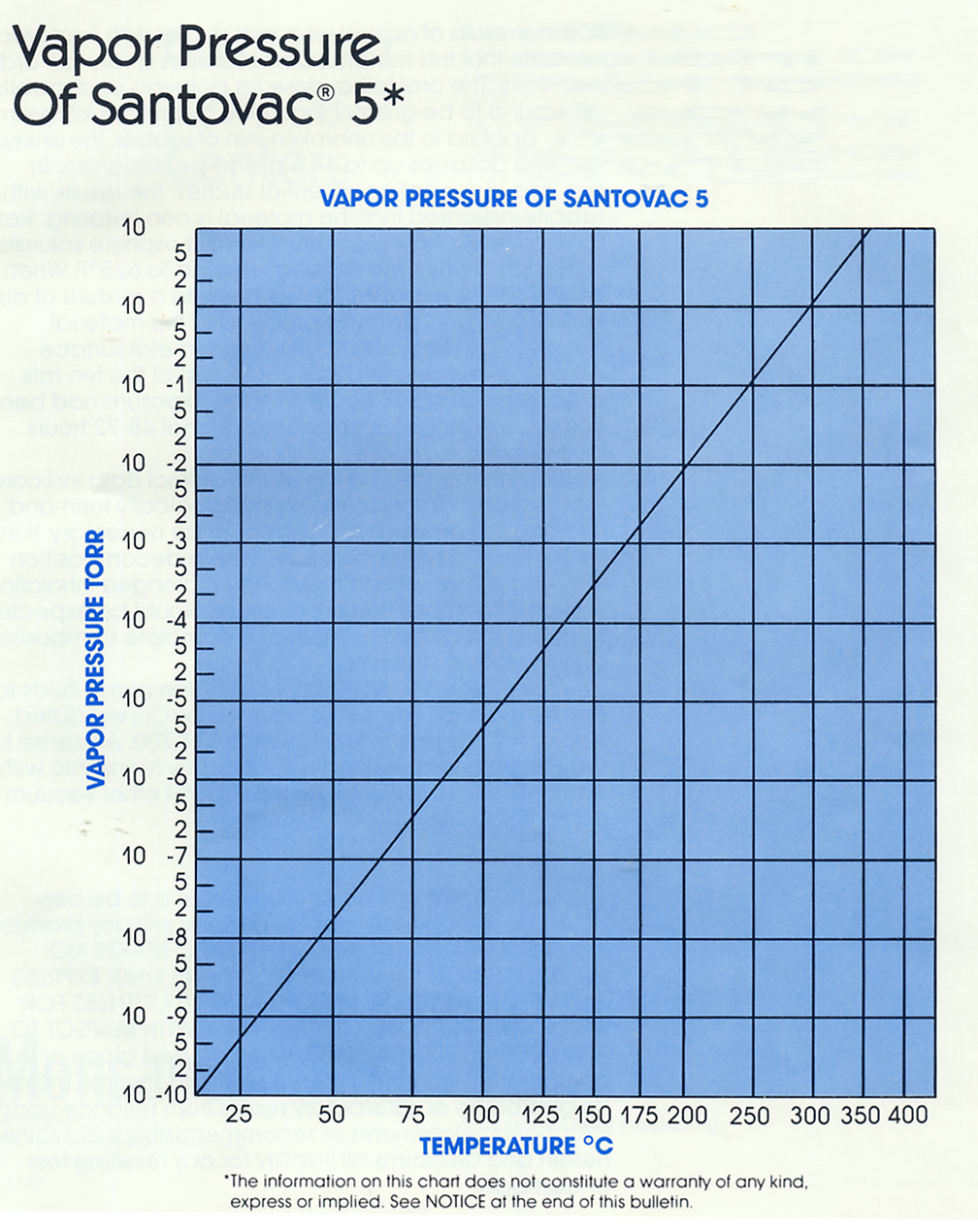Low Backstreaming
Backstreaming depends on the vapor pressure of the fluid and its overall characteristics, the system design, the operating conditions and the temperature of the collecting surface. Santovac 5 has inherently low backstreaming characteristics.
Low backstreaming can result in less contanmination processes that are sensitive to organic matter. Experience has shown us that polyphenyl ether type fluids like Santovac 5 pump fluid can be used for electronic component manufacture, and for laboratory, analytical, instrumental and research applications.
High Thermal Stability
Santovac 5 offers unusually high thermal and oxidation stability. Isoteniscope tests show that Santovac 5 remains thermally stable at 870 F. Santovac 5 may discolor with use, but this does not affect its operation as a diffusion pump fluid. Oxidation and corrosion tests, as well as field experience, have shown that Santovac 5 has little tendency to increase in viscosity during the standard testing. These results indicate that there is less chance of overheating and thermal degradation. F. Santovac 5 may discolor with use, but this does not affect its operation as a diffusion pump fluid. Oxidation and corrosion tests, as well as field experience, have shown that Santovac 5 has little tendency to increase in viscosity during the standard testing. These results indicate that there is less chance of overheating and thermal degradation.
The corrosion portion of the test indicates that Santovac 5 is generally compatible with the metallic materials most often used in diffusion pump manufacture.
Clean and Easy to Use
Absorbed films of Santovac 5 are easier to remove than silicone films. Santovac 5 can be easily baked off in vacuum or cleaned with standard solvents.
Radiation Resistance
Polyphenyl ethers like Santovac 5 pump fluid are among the most radiation resistant organic fluids available. Tests have shown resistance up to 10 ergs/gm of carbon. ergs/gm of carbon.
Elastomer Compatability
Viton, Teflon, butyl and silicone have been found to be generally compatible with Santovac 5. Since elastomer manufacturers are continually formulating and testing new compounds, designers who desire the latest available data should contact the packing and seal suppliers directly. The compatability of other nonmetallic materials should be checked by tests with the fluid under simulated conditions of use.
Typical properties of Santovac 5
Vapor Pressure at 25 .............................................................................................................4 .............................................................................................................4 10 10 torr torr
Boiling Point at 0.5 torr..............................................................................................................275
Specific Gravity, 25/25 ............................................................................................................1.198 ............................................................................................................1.198
Viscosity, cs
 at 27 at 27 ....................................................................................................................................1000 cs ....................................................................................................................................1000 cs
 at 38 at 38 ....................................................................................................................................363 cs ....................................................................................................................................363 cs
 at 99 at 99 ....................................................................................................................................13.1
cs ....................................................................................................................................13.1
cs
 at 149 at 149 ..................................................................................................................................4.5 cs ..................................................................................................................................4.5 cs
 at 204 at 204 ..................................................................................................................................2.1 cs ..................................................................................................................................2.1 cs
 at 260 at 260 ..................................................................................................................................1.2 cs ..................................................................................................................................1.2 cs
Pour Point
....................................................................................................................................5
Flash Point [COC] ......................................................................................................................288
Fire Point [COC] .........................................................................................................................349
Autogeneous Ignition Temperature .......................................................................................590
Refractive Index, N ................................................................................................................1.6306 ................................................................................................................1.6306
Latent Heat of Vaporization [355-475 ]
............................................................................... 49.2 cal/g ]
............................................................................... 49.2 cal/g
Average Molecular Weight ........................................................................................................454
Specific Heat at 20 .................................................................................................................0.35 .................................................................................................................0.35
Thermal Conductivity, Watts/m  K at 20 K at 20 .............................................................................0.1330 .............................................................................0.1330
Density
 at 20 at 20 .....................................................................................................................................1.204 .....................................................................................................................................1.204
 at 38 at 38 ....................................................................................................................................1.187 ....................................................................................................................................1.187

|
|